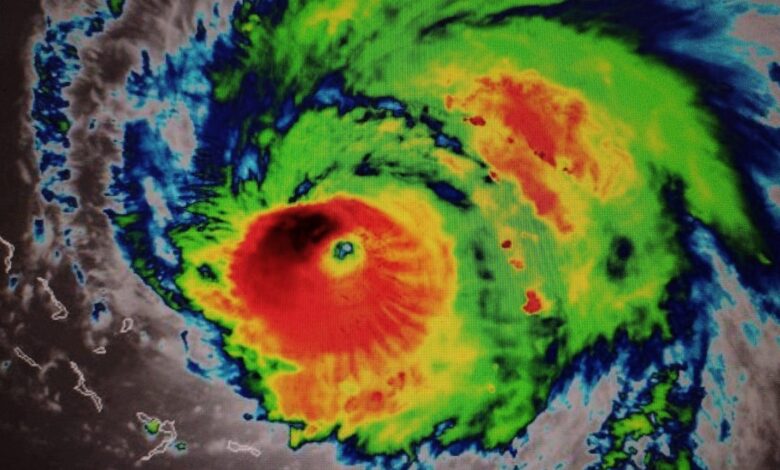Everything you need to prepare for hurricane season

If you live in a hurricane risk zone, you know the transition from summer to fall always brings the threat of storms. Hurricanes affect people living on the coast, and remnants of a hurricane can also cause damage hundreds of miles from the shore. As someone who has lived in three major hurricane-risk cities, I’ve undergone my fair share of tropical storms and cyclones, learning a thing or two about best preparation practices.
Also: 7 ways to prep your tech for the coming storms
Creating an action plan is the first essential step when preparing for a hurricane. Write down emergency phone numbers, prepare an emergency supply kit, and locate the nearest shelter or evacuation route. If you are undergoing the storm from home, here are some essential items to prepare and be mindful of.
A generator
Widespread power outages are one of the most common ramifications of a hurricane. Due to high winds, flooding, and falling trees, power lines, electrical substations, and other critical infrastructures are heavily affected. When this occurs, a generator can save your life by restoring power to essential appliances, such as a fridge, a furnace, or a life support machine.
Remember, you should never use a generator inside, and always keep it 20 feet away from your home since the carbon monoxide produced can kill you.
The All-Power 9000W Generator runs on gasoline or propane, making it the perfect backup emergency power. The gasoline tank has a capacity of 6.6 gallons and will run for up to 10 hours of operation at half-load. Since it does not have a push-button start, you must use the electric or the pull cord start. While this model has carbon monoxide (CO) sense technology – meaning it will stop the generator and alert you when the system detects CO – you should never use a generator inside your house.
Known for its quiet operation at 60dB, the Generac 8000W generator is the best generator to use in residential neighborhoods or areas where children reside. Powered by gas, the Generac 8000W utilizes an electric or pull cord start and runs for up to 12 hours of operation at half load. The generator has wheels and a handle to maneuver easily, and features carbon monoxide sense technology.
Like the All-Power 9000, the DuroMax 13000W runs on gasoline and propane, allowing flexibility in choosing your fuel. A 500cc OHV Duromax Engine powers the generator, providing an 8.3-gallon gasoline tank. Nonetheless, the generator will run up to eight hours of operation at half load on gasoline and six hours on propane and can handle loads from lights, refrigerators, and home conditioners. It is EPA and CARB-approved for use in all 50 states.
A portable power station
If you are looking for something that is more portable than a generator and don’t want the hassle of dealing with gasoline, propane, or diesel fuel from a generator, a portable power station is your best option. While the output power capacity is lower than a generator, a portable power station is silent and emission-free.
Usually powered by rechargeable lithium-ion batteries or solar panels, a power station can be used indoors as an addition to your generator to recharge smaller devices and appliances such as phones, laptops, or medical equipment.
With a 4085.6Wh capacity, the Jackery Solar Generator Kit 4000 can power heavy-duty devices up to 3000W. Operating at just 30dB, this power station barely makes noise and fully charges in two hours with 6*SolarSaga 200W solar panels or by connecting it to a wall outlet. The advanced cooling system makes it high-temperature, shock, and fire-resistant.
In just 50 minutes, this compact portable power station charges from 0% to 80% due to its ultra-fast recharging feature. Weighing just 25 pounds, the UGREEN PowerRoam 1200 is a lightweight, reliable home backup power that can support appliances of up to 25000W.
If you want some power but don’t want huge amounts of it, the EcoFlow River 2 is the best option for those looking a quick emergency recharge. In just one hour, you can fully recharge your power station. With an output of 600W, you can run six essential appliances simultaneously, with two AC outlets, one USB-C Port, two USB-A ports, and one car outlet.
Goal Zero Yeti 6000X is best for emergencies with prolonged power outages since it can recharge with solar, wall outlets, or vehicles. While the power station weighs 106 pounds, it comes with a wheeled trolley, allowing you to move it wherever needed. The Goal Zero Yeti 6000X has seven different types of outlets and can power almost anything in your home due to its impressive 2,000-watt or 120-volt output.
A storm tracker website
During a hurricane, making informed decisions is crucial. Items you already own, such as a tablet or a smartphone, can help you stay out of harm’s way by allowing you to track and keep up with a storm. Here are some of the best apps and websites you can keep an eye on if you’re in high-risk hurricane areas to keep informed.
If you want to know a projected hurricane path or whether there are any threats of storms, cyclones, or hurricanes in the Eastern Pacific and the Atlantic, the NOAA National Hurricane Center website is the best website to bookmark on all your devices. The National Hurricane Center is the central source most applications use as a data source and offers the most up-to-date information about where a hurricane is heading or how its behavior might change.
A flashlight
While your phone flashlight may seem enough in your regular day-to-day, a physical flashlight is an essential tool in an emergency kit. In addition to lighting the way, a bright flashlight is a great tool to help find people who require rescue or want to signal for help. Remember, your phone flashlight may not shine bright enough in case of an emergency or may even run out of battery extremely quickly.
This versatile flashlight emits a bright beam of up to 1700 lumens and can illuminate up to 353 meters, making the PD35R a great addition to any emergency kit. It is USB-C rechargeable and provides over 100 hours of runtime on the lower setting when fully charged. The steel clip lets you attach the flashlight to any backpack, belt, or lanyard. It has excellent performance and is convenient for different types of uses.
Known as the world’s brightest flashlight, the Imalent SR32 has a maximum output of 120,000 lumens and can illuminate up to 2080 meters. This flashlight is USB-C rechargeable and fully charges within 1.5 hours. It has an impressive 360 hours of battery life, and it is dust and water-resistant, making it a great emergency tool in case of power outages or floods caused by remnants of a hurricane.
The Olight Marauder 2 is a powerful and flexible handheld flashlight. It has a great battery life of up to 59 hours and offers a built-in 54Wh power rechargeable pack that can be used to charge your phone or devices in case of any power outages or emergencies. It has a maximum output of 14,000 lumens and a maximum throw of 800 meters and offers two different modes that you can switch between with a simple toggle switch.
If you are looking for a waterproof flashlight, the Coast Polysteen 600R is a 530-lumen rechargeable LED flashlight that is both dust- and crush-proof. The flashlight is powered by a custom rechargeable battery pack or four AA batteries, offering a 35-hour runtime. It is completely waterproof and features a USB charging port in case any of your devices need some quick juice during an emergency.
Rechargable batteries
Most emergency tools use batteries, which means having top-performing rechargable batteries in your emergency kit is a must. Whether to power walkie-talkies, a radio, or even to replace your flashlight’s battery, keeping extra batteries as backup is vital. Here are some of the best ones we recommend.
With a 4.5-star review on Amazon, the POWEROWL AA rechargeable batteries are a favorite to many, including ZDNET’s Jack Wallen, who stumbled upon the batteries during the pandemic and now claims them as his “go-to batteries”. These batteries have a 2800mAh high capacity and can be recharged over 1,200 times. The pack comes with a POWEROWL smart battery charger that constantly checks the conditions of the batteries and can charge one or all eight batteries simultaneously.
Review: I took a chance on these rechargeable batteries and now they’re my go-to
The Amazon Basics 24-Pack Rechargeable AA Batteries are an excellent budget alternative for those looking for extra batteries they can use at a moment’s notice. The NiMH batteries (2,000 mAh) are ideal for remote controls, radios, clocks, or flashlights. They can be recharged up to 1000 times and have a shelf-life of up to five years for everyday or emergency use.
The Panasonic Eneloop pro High Capacity Rechargeable Batteries Power Pack makes for the perfect battery starter kit since it comes with both AA and AAA batteries. They offer a capacity of 2550mAh and can be charged up to 500 times. The convenient plastic battery storage case is an added bonus since it allows you to keep them securely stored in an emergency bag.
You might also need:
Hurricanes will sweep anything in their path and often come with little preparation time or warning, which means the time to prepare for one is now. While there may be no current hurricane threats in your area, stay vigilant through the National Hurricane Center and gather all the essentials you need before, during, and after a hurricane. Below are some additional items you may need during a storm.
You never know the extent of damage a hurricane can cause to your house, neighborhood, or city. Therefore the best way to prepare is by creating different plans for various scenarios. Some ways the CDC recommends planning include:
- Establish an emergency evacuation route: Create emergency evacuation routes to nearby shelters or towns that are not under an evacuation mandate, and make sure you always listen to authorities about whether or not you should stay home. This also includes writing down emergency phone numbers in multiple locations and areas of your house.
- Prepare your car: Before a storm hits, make sure your car has a full tank and is parked in a secure location. You never know when you will have to leave in a hurry or when you may be able to fill your tank again.
- Prepare an emergency supply kit: Gathering emergency supplies is essential when preparing for a hurricane. Keep an emergency supply kit in your car and in your home. Supplies that can keep you and your family safe include food and water supplies, medicine supplies, emergency power sources (radio, flashlight, power banks), and personal items or documents.
- Talk with your family: Whether you live by yourself or with a group of people, make sure people in your immediate circle are aware of your plans. Talk through where you will spend the hurricane, your emergency evacuation plans, and how you will communicate in case of power outages or any severe aftermath.
Make sure you charge all your gadgets in advance, and keep an eye on the weather. If you are evacuating your home before a storm, make sure you unplug all of your appliances and devices.
In the United States, hurricane season is typically from June 1 to November 30, although storms and cyclones can occur before or after. Late August to September are considered the worst months for hurricanes. This time of year is considered the Atlantic Hurricane Season and often affects the Caribbean, Central America, as well as South and East United States.




